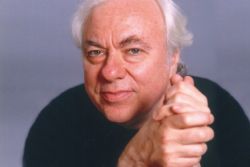|
Symphony
MONUMENTAL MAHLER 5TH IN SO CO PHIL'S SEASON ENDING CONCERT
by Terry McNeill
Sunday, April 14, 2024
Chamber
OAKMONT SEASON CLOSES WITH STRAUSS' PASSIONATE SONATA
by Terry McNeill
Thursday, April 11, 2024
Chamber
MORE GOLD THAN KORN AT ALEXANDER SQ CONCERT
by Terry McNeill
Sunday, April 7, 2024
Choral and Vocal
VIBRANT GOOD FRIDAY REQUIEM AT CHURCH OF THE ROSES
by Pamela Hicks Gailey
Friday, March 29, 2024
TWO OLD, TWO NEW AT THE SR SYMPHONY'S MARCH CONCERT IN WEILL
by Peter Lert
Saturday, March 23, 2024
Chamber
NOT A SEVENTH BUT A FIRST AT SPRING LAKE VILLAGE CONCERT
by Terry McNeill
Wednesday, March 20, 2024
THIRTY-THREE PLUS VARIATIONS AND AN OCEAN VIEW
by Terry McNeill
Saturday, March 16, 2024
Choral and Vocal
A ST. JOHN PASSION FOR THE AGES
by Abby Wasserman
Friday, March 8, 2024
Choral and Vocal
SPLENDID SCHUBERT SONGS IN SANET ALLEN RECITAL
by Terry McNeill
Saturday, March 2, 2024
Chamber
SHAW'S MICROFICTIONS HIGHLIGHTS MIRO QUARTET'S SEBASTOPOL CONCERT
by Peter Lert
Friday, March 1, 2024
|
 |
 Pianist Richard Goode |
MASTERFUL PIANISM IN GOODE'S WEILL HALL RECITAL
by Sonia Morse Tubridy
Friday, May 5, 2017
Pianist Richard Goode programmed an evening of treasures May 5 from four great composers, and is an artist of intimacy and intelligence, power and passion, able to go deep and to soar. Hearing Mr. Goode play this literature was a reminder of how music does indeed bridge worlds and time.
Bach’s E minor Partita (BWV 830) opened the Weill Hall program in a toccata of cascades and streams of arpeggios and fanciful chromatic flights leading to a serious and thoughtful fugue. The playing was straightforward with delightful use of pedal and touches of rubato. Mr. Goode uses the piano with all its colors and articulations, never locking Bach into "period" playing or attempting to imitate our poor knowledge of early styles. The allemande was elegant and playful, delicate and with rich tone, leading into the jolly corrente with its syncopated fun. Here the tempo was lively, allowing clusters of notes to be heard as units, and occasional additions of accents highlighted phrases creatively. Then came the air with solid weighted sound and some grandeur building to the sarabande. The slow and exotic sarabande is often the heart of a suite and so it was here: mysterious harmonies seeming often bent and twisted with heart wrenching suspensions, and very ornate writing leading to passionate peaks of emotion. The breezy relief of the tempo di gavotte, a simple joyful dance, preceded a tour de force gigue which was clear with all its complexity of fugal structure, syncopations and tumbling wild leaps. All voices were audible and unforced. There was no separation between pianist, instrument and composer.
Following the Bach the pianist chose Brahms’ 6 Klavierstucke, Op. 118. The juxtaposition of these two composers was inspired and one could hear the connection between Bach and Brahms through their chromatic harmonies, complex thematic work, dense textures and lovely lyricism. Opus 118 starts with an agitated wave of sounds rising out of the piano’s depths, beauty searching for a place in time. This is followed by a Romantic Lied and then a heavenly duet, a prayerful moment and and finally the duet returns with Mr. Goode bringing out inner voices with expert shadings. The third piece is a ballade, a story of impetuous adventure and a sense of hopeful endings. This had great clusters of sound with rapid tempo, but was never percussive. A charmingintermezzo led to a romance, a piece with warm spaciousness. The artist brought out the folk elements and had the piano imitating sounds of nature, birds, water, wind, sunshine and dark. The final Intermezzo is very mysterious and travels through mazes of searching harmonies, often very dark, to a triumph of joy and hope.
Following intermission the program continued with Chopin’s Nocturne in B Major, Op. 62, No. 1; three mazurkas (Op. 41 Nos. 2 and 3, and Op. 50, No. 3), and the Polonaise-fantaisie, Op. 61. The Nocturne was played movingly by this master of big and small gestures, color at his fingertips, trills creating shimmering melodies, the music glowing. Mr. Goode seemed to magically exceed the limitations of a piano. In the Mazurkas he created simplicity, Polish character, folk sounds, delicacy and heroism. The pianist was portraying dancing and weaving tales. The Polonaise-fantaisie commenced with tragic chords and delicate sounds rose out of them. Spectacular pianism with exquisite chord voicing led to the end where the last sounds heard could invoke "Ring the bells that still can ring…" (L. Cohen).
The evening’s finale was Beethoven's Sonata A Major Sonata,Op. 101. The allegretto was orchestral in its rocking rhythms and the vivace ala marcia had humor with sweetness always creeping in. One had a feeling of improvisation within a highly ordered environment. The Schumannesque recitative of the adagio was poignant. The rising interval of a sixth was a beautiful returning pianistic gesture, and the fugue was energetic and wild, at times possessed, but the pianist managed to keep careful melodic control. It was splendid!
An enthusiastic ovation followed from the audience of 400 and generated an encore: Janacek’s "Good Night" from the 1908 Suite “On An Overgrown Path.”
|
